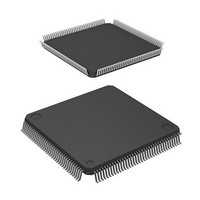D12674RVFQ33D Renesas Electronics America, D12674RVFQ33D Datasheet - Page 772

D12674RVFQ33D
Manufacturer Part Number
D12674RVFQ33D
Description
MCU 3V 0K I-TEMP 144-QFP
Manufacturer
Renesas Electronics America
Series
H8® H8S/2600r
Datasheet
1.D12674RVFQ33V.pdf
(981 pages)
Specifications of D12674RVFQ33D
Core Processor
H8S/2600
Core Size
16-Bit
Speed
33MHz
Connectivity
IrDA, SCI
Peripherals
DMA, POR, PWM, WDT
Number Of I /o
103
Program Memory Type
ROMless
Ram Size
32K x 8
Voltage - Supply (vcc/vdd)
3 V ~ 3.6 V
Data Converters
A/D 12x10b; D/A 4x8b
Oscillator Type
Internal
Operating Temperature
-40°C ~ 85°C
Package / Case
144-LQFP
Lead Free Status / RoHS Status
Contains lead / RoHS non-compliant
Eeprom Size
-
Program Memory Size
-
Other names
HD6412674RVFQ33D
HD6412674RVFQ33D
HD6412674RVFQ33D
Available stocks
Company
Part Number
Manufacturer
Quantity
Price
Company:
Part Number:
D12674RVFQ33DV
Manufacturer:
Renesas Electronics America
Quantity:
10 000
- Current page: 772 of 981
- Download datasheet (6Mb)
Section 15 Serial Communication Interface (SCI, IrDA)
As in the above sample start character, with the direct convention type, the logic 1 level
corresponds to state Z and the logic 0 level to state A, and transfer is performed in LSB-first order.
The start character data above is H'3B. For the direct convention type, clear the SDIR and SINV
bits in SCMR to 0. According to the Smart Card regulations, clear the O/E bit in SMR to 0 to
select even parity mode.
With the inverse convention type, the logic 1 level corresponds to state A and the logic 0 level to
state Z, and transfer is performed in MSB-first order. The start character data above is H'3F. For
the inverse convention type, set the SDIR and SINV bits in SCMR to 1. According to the Smart
Card regulations, even parity mode is the logic 0 level of the parity bit, and corresponds to state Z.
In this LSI, the SINV bit inverts only data bits D7 to D0. Therefore, set the O/E bit in SMR to 1 to
invert the parity bit for both transmission and reception.
15.7.3
Operation in block transfer mode is the same as that in normal Smart Card interface, except for the
following points.
15.7.4
Only the internal clock generated by the on-chip baud rate generator is used as transmit/receive
clock in Smart Card interface. In Smart Card interface mode, the SCI operates on a basic clock
with a frequency of 32, 64, 372, or 256 times the bit rate (fixed at 16 times in normal
asynchronous mode) as determined by bits BCP1 and BCP0. In reception, the SCI samples the
Rev. 3.00 Mar 17, 2006 page 720 of 926
REJ09B0283-0300
In reception, though the parity check is performed, no error signal is output even if an error is
detected. However, the PER bit in SSR is set to 1 and must be cleared before receiving the
parity bit of the next frame.
In transmission, a guard time of at least 1 etu is left between the end of the parity bit and the
start of the next frame.
In transmission, because retransmission is not performed, the TEND flag is set to 1, 11.5 etu
after transmission start.
As with the normal Smart Card interface, the ERS flag indicates the error signal status, but
since error signal transfer is not performed, this flag is always cleared to 0.
Block Transfer Mode
Receive Data Sampling Timing and Reception Margin
(Z)
Figure 15.24 Inverse Convention (SDIR = SINV = O/E E E E = 1)
Ds
A
D7 D6 D5 D4 D3 D2 D1 D0 Dp
Z
Z
A
A
A
A
A
A
Z
(Z) State
Related parts for D12674RVFQ33D
Image
Part Number
Description
Manufacturer
Datasheet
Request
R

Part Number:
Description:
CCD Vertical Clock Driver
Manufacturer:
Sony Corporation
Datasheet:

Part Number:
Description:
KIT STARTER FOR M16C/29
Manufacturer:
Renesas Electronics America
Datasheet:

Part Number:
Description:
KIT STARTER FOR R8C/2D
Manufacturer:
Renesas Electronics America
Datasheet:

Part Number:
Description:
R0K33062P STARTER KIT
Manufacturer:
Renesas Electronics America
Datasheet:

Part Number:
Description:
KIT STARTER FOR R8C/23 E8A
Manufacturer:
Renesas Electronics America
Datasheet:

Part Number:
Description:
KIT STARTER FOR R8C/25
Manufacturer:
Renesas Electronics America
Datasheet:

Part Number:
Description:
KIT STARTER H8S2456 SHARPE DSPLY
Manufacturer:
Renesas Electronics America
Datasheet:

Part Number:
Description:
KIT STARTER FOR R8C38C
Manufacturer:
Renesas Electronics America
Datasheet:

Part Number:
Description:
KIT STARTER FOR R8C35C
Manufacturer:
Renesas Electronics America
Datasheet:

Part Number:
Description:
KIT STARTER FOR R8CL3AC+LCD APPS
Manufacturer:
Renesas Electronics America
Datasheet:

Part Number:
Description:
KIT STARTER FOR RX610
Manufacturer:
Renesas Electronics America
Datasheet:

Part Number:
Description:
KIT STARTER FOR R32C/118
Manufacturer:
Renesas Electronics America
Datasheet:

Part Number:
Description:
KIT DEV RSK-R8C/26-29
Manufacturer:
Renesas Electronics America
Datasheet:

Part Number:
Description:
KIT STARTER FOR SH7124
Manufacturer:
Renesas Electronics America
Datasheet:

Part Number:
Description:
KIT STARTER FOR H8SX/1622
Manufacturer:
Renesas Electronics America
Datasheet:











